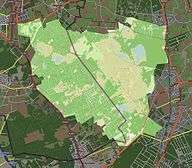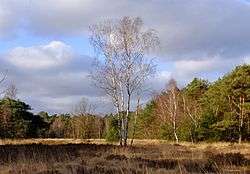De Zoom–Kalmthoutse Heide
| De Zoom–Kalmthoutse Heide Cross-Border Park | |
|---|---|
| Grenspark De Zoom - Kalmthoutse Heide | |
|
IUCN category II (national park) | |
|
| |
 Map of the National Park | |
| Location | North Brabant, Netherlands and Antwerp, Belgium |
| Coordinates | 51°23′43″N 4°26′28″E / 51.39528°N 4.44111°ECoordinates: 51°23′43″N 4°26′28″E / 51.39528°N 4.44111°E |
| Area | 37.5 km2 (14.5 sq mi) |
| Established | 2001 |
| Governing body | Bijzondere Commissie "Grenspark De Zoom-Kalmthoutse Heide" |
|
www | |
| Official name | Kalmthoutse Heide |
| Designated | 4 March 1986 |
| Reference no. | 330[1] |
De Zoom–Kalmthoutse Heide is a cross-border park on the Belgian–Dutch border. It is a merger of two former parks, the Kalmthoutse Heide in Belgium and De Zoom in the Netherlands, together extending over 37.50 square kilometres (14.48 sq mi). A very large part of the park is covered with heath.
The park is managed by a special commission in which both Flemish and Dutch organisations are represented. The park is owned by the state of Flanders, the municipality Kalmthout, Staatsbosbeheer, Natuurmonumenten and several private owners. The best known part of the border park lies in Belgium, in the north of the province of Antwerp (Kalmthout and Essen). The Dutch part lies in the municipality Woensdrecht (province North Brabant) and stretches from the border to the villages Huijbergen and Putte.
Fauna
As we walk in the Kalmthoutse Heide, we can notice some remarkable species, such as Smooth snake, Viviparous lizard and Crested newt, as well as Moor frog. Rare butterfly species are Green hairstreak, Grayling, Silver-studded blue, Chequered skipper and Clouded yellow. In nearby nature reserves, we can find even rarer species: Klein Schietveld: Grizzled skipper: one of the largest and last remaining populations of this species in Flanders. Groot Schietveld: Alcon blue: even threatened on European scale and ofcours very restricted in Flanders: only found in the north-east of Belgium. This species used to occur in the wet heathlands of the Kalmthoutse Heide, but because of the lack of larval foodplants, this species is now considered extinct, even though occasionally eggs are found.
References
- ↑ "Kalmthoutse Heide". Ramsar Sites Information Service. Retrieved 25 April 2018.
External links
| Wikimedia Commons has media related to Kalmthoutse Heide. |
.jpg)
